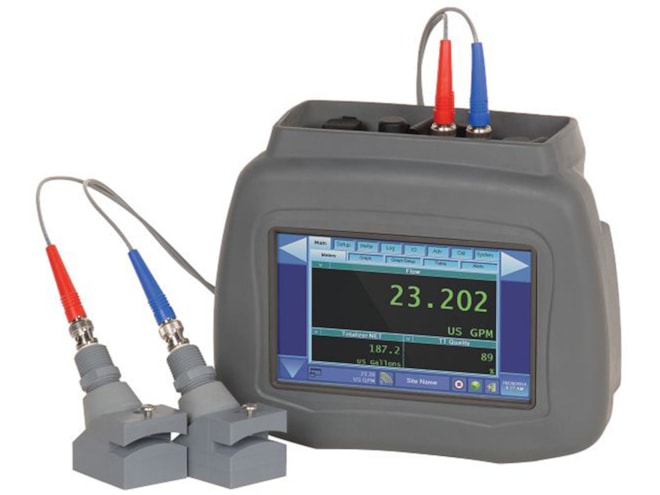The Dynasonics DXN Ultrasonic Flow Meter is a portable true hybrid ultrasonic flow meter, capable of measuring liquid flow with multiple technologies, including: Doppler, Transit Time and Liquid Thermal (Heat Energy) Flow. DXN is also compatible with a pipe wall thickness gauge, used to verify inside pipe diameter and ensure highly accurate ultrasonic measurements when piping details are unknown or unavailable.
The DXN has a number of advanced features that allow the user to obtain accurate readings while capturing flow surges and high-speed batch operations. DXN captures and records multiple application parameters at one time with an easy-to-use data logging function and provides the power to verify and troubleshoot permanent flow installations with ease.
Dynasonics DXN Ultrasonic Flow Meters Include:
Basic Kit
- 1 set of small-pipe transit time transducers, pipe sizes ½ to 2in (12 to 50mm)
- 1 set of standard transit time transducers, pipe sizes 2in (50mm) and higher
- 20ft (6m) cable sets, quick disconnect; 4 SS mounting straps; acoustic couplant
All Transit Time Kit
- Basic kit
- 1 set of large pipe transit time transducers, pipe sizes >24in (600mm)
Hybrid Kit
- Basic kit
- 1 set of doppler transducers, pipe sizes 1in (25mm) and larger
Energy Kit
- Basic kit
- 2 noninvasive Pt1000 RTD's, 0 to 266°F (0 to 130°C), 20ft (6m) cable, mounting compound
Full Kit
- All transit time
- The doppler and the energy package
- Pipe wall thickness gauge
Ultrasonic Flow Rate Measurement
Transit time flow meters measure the time difference between the travel time of an ultrasound wave going with the fluid flow and then against the fluid flow. This time difference is used to calculate the velocity of the fluid traveling in a closed-pipe system. The transducers used in transit time measurements operate alternately as transmitters and receivers. Transit time measurements are bi-directional and are most effective for fluids that have low concentrations of suspended solids.
Doppler flow meters operate by transmitting an ultrasonic wave from a transmitting transducer through the pipe wall and into the moving liquid. The sound wave is "reflected" by suspended particles or bubbles moving with the liquid and ultimately gathered by the receiving transducer. A frequency shift (Doppler effect) will occur that is directly proportional to the speed of the moving particles or bubbles. This shift in frequency is interpreted by the digital signal processor (DSP) and converted to a fluid velocity measurement.
Regardless of the method used to determine velocity, multiplying the pipe's cross sectional area by the fluid velocity produces a volumetric flow rate. The measurement also presumes that the pipe is completely full during the measurement cycle.
Energy Monitoring
Temperature measurements, when used in conjunction with flow measurement, can yield energy usage readings in the form of heat flow. Energy usage is calculated by multiplying the flow rate of the heat transfer fluid by the change of heat content in that fluid after it has done some kind of work, to find the net heat loss or gain.
An ultrasonic meter equipped with heat flow capabilities is designed to measure the rate and quantity of heat delivered or removed from devices such as heat exchangers. The instrument measures the volumetric flow rate of the heat exchanger liquid, the temperature at the inlet pipe and the temperature at the outlet pipe. By applying a scaling factor this heat flow measurement can be expressed in the units of your choosing: BTU, Watts, Joules, Kilowatts, etc.


















